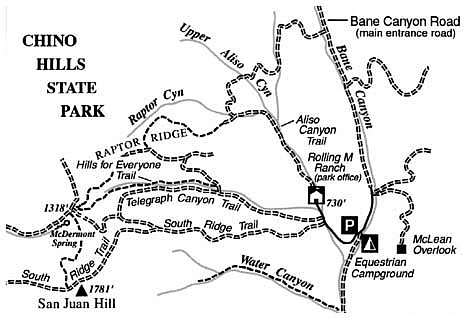 Facebook
Facebook
 X
X
 Instagram
Instagram
 TikTok
TikTok
 Youtube
Youtube
The Hills for Everyone Trail (actually reserved for hikers only -- no mountain bikes or equestrian allowed), commemorates "Hills for Everyone," a conservation organization that was instrumental in the establishment of the 13,000-acre Chino Hills State Park. The trail runs up an unnamed tributary of the larger Aliso Canyon, and is beautifully shaded by live oak, walnut, sycamore, elderberry, and toyon. The native "California walnut" trees here are endemic to the foothill region surrounding the Los Angeles basin. San Diego County lies just outside their native range. In the next month or so, both the walnut and sycamore trees will show their best autumnal colors.
To get to the trailhead from San Diego follow Interstate 15 north to Corona. Exit at the westbound Highway 91 (Riverside Freeway), continue 5.5 miles, and take Highway 71 north. After seven miles, exit at Soquel Canyon Parkway. Drive west on Soquel Canyon Parkway 1.0 mile to Elinvar Drive. Turn left, left again after 0.2 mile, and then immediately right on the gravel road signed "Chino Hills State Park." That road, through Bane Canyon, is open during park hours, 8 a.m. to sunset. After one-half mile you arrive at the park's entrance station. After two miles, the road becomes paved and bends sharply right. Continue all the way to the end of the pavement, and park in the lot at Rolling M Ranch, the site of the park office.
On foot now, walk south on the paved entrance road for about 200 yards, then turn right (west) on the Telegraph Canyon Trail -- a maintained dirt road closed to motor traffic. After a near-flat 0.9 mile of travel, look for the Hills for Everyone Trail on the right, which follows a ravine (another, wider trail continues north to Raptor Ridge). For the next 1.3 miles you stick close to the bottom of that ravine. In winter and spring, water courses through here, nourishing a moist, dark understory of wild berry vines, ferns, nettles, watercress, and other riparian vegetation. Near the top of the trail, filtered sunlight illuminates wild grape vines draped among the oak trees.
At the top you come to a saddle, part of a major watershed divide in the Chino Hills, where several trails come together. Just west of that saddle is McDermont Spring, an old stock pond filled with cattails. Nearby an old windmill groans as it pumps water into a metal tank. Look for frogs, pond turtles, and a host of birds before you return the same way.


The Hills for Everyone Trail (actually reserved for hikers only -- no mountain bikes or equestrian allowed), commemorates "Hills for Everyone," a conservation organization that was instrumental in the establishment of the 13,000-acre Chino Hills State Park. The trail runs up an unnamed tributary of the larger Aliso Canyon, and is beautifully shaded by live oak, walnut, sycamore, elderberry, and toyon. The native "California walnut" trees here are endemic to the foothill region surrounding the Los Angeles basin. San Diego County lies just outside their native range. In the next month or so, both the walnut and sycamore trees will show their best autumnal colors.
To get to the trailhead from San Diego follow Interstate 15 north to Corona. Exit at the westbound Highway 91 (Riverside Freeway), continue 5.5 miles, and take Highway 71 north. After seven miles, exit at Soquel Canyon Parkway. Drive west on Soquel Canyon Parkway 1.0 mile to Elinvar Drive. Turn left, left again after 0.2 mile, and then immediately right on the gravel road signed "Chino Hills State Park." That road, through Bane Canyon, is open during park hours, 8 a.m. to sunset. After one-half mile you arrive at the park's entrance station. After two miles, the road becomes paved and bends sharply right. Continue all the way to the end of the pavement, and park in the lot at Rolling M Ranch, the site of the park office.
On foot now, walk south on the paved entrance road for about 200 yards, then turn right (west) on the Telegraph Canyon Trail -- a maintained dirt road closed to motor traffic. After a near-flat 0.9 mile of travel, look for the Hills for Everyone Trail on the right, which follows a ravine (another, wider trail continues north to Raptor Ridge). For the next 1.3 miles you stick close to the bottom of that ravine. In winter and spring, water courses through here, nourishing a moist, dark understory of wild berry vines, ferns, nettles, watercress, and other riparian vegetation. Near the top of the trail, filtered sunlight illuminates wild grape vines draped among the oak trees.
At the top you come to a saddle, part of a major watershed divide in the Chino Hills, where several trails come together. Just west of that saddle is McDermont Spring, an old stock pond filled with cattails. Nearby an old windmill groans as it pumps water into a metal tank. Look for frogs, pond turtles, and a host of birds before you return the same way.
